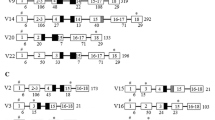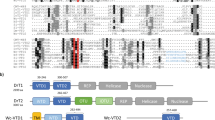Abstract
We have cloned a porcine gene, designated TBP10, that belongs to the Tat-binding protein/26S protease subunit family. The genomic structure of the porcine TBP10 gene was analyzed after isolation of three overlapping genomic phage lambda clones. The TBP10 gene harbors 12 exons spanning 4.5 kb of chromosomal DNA. The TBP10 gene was assigned to Chromosome (Chr) 12 by fluorescence in situ hybridization (FISH) on metaphase chromosomes. The chromosomal location was confirmed by PCR analysis of a porcine-rodent hybrid cell panel. The TBP10 protein is encoded by a 1221 nucleotide cDNA and has a molecular mass of 45.6 kDa. The predicted amino acid sequence has highest similarity to the human and bovine p45 subunit of the 26S protease and the human transcription factor TRIP1. Further similarities were detected to the slime mold protein DdTBP10 and the Schizosaccharomyces pombe and Saccharomyces cerevisiae protein SUG1. Like DdTBP10 and other members of the protein family, the porcine TBP10 harbors a leucine zipper motif in the N-terminal region and a domain characteristics of ATP-dependent proteases in the C-terminal region.
Similar content being viewed by others
References
Akiyama, K., Yokota, K., Kagawa, S., Shimbara, N., DeMartino, G.N., Slaughter, C.A., Noda, C., Tanaka, K. (1995). CDNA cloning of a new putative ATPase subunit p45 of the human 26S proteasome, a homolog of the yeast transcriptional factor Suglp. FEBS Lett. 363, 151–156.
Ausubel, F.M., Brent, R., Kingston, R.E., Moore, D.D., Seidman, J.G., Smith, J.A., Struhl, K. (1990). Current Protocols in Molecular Biology, (New York: John Wiley and Sons).
Cao, J.-G., Firtel, R.A. (1995). Growth and developmental functions of a human immunodeficiency virus tat-binding protein/26S protease subunit homolog from Dictyostelium discoideum. Mol. Cell. Biol. 15, 1725–1736.
Chevalet, C., Corpet, F. (1986). Statistical decision rules concerning synteny or independence between markers. Cytogenet. Cell Genet. 43, 132–139.
Confalonieri, F., Marsault, J., Duget, M. (1994). SAV1 an archeabacterial gene with extensive homology to a family of highly conserved eukaryotic ATPases. J. Mol. Biol. 235, 396–401.
Coppieters, W., Van de Weghe, A., Peelman, L., Depicker, A., Van Zeveren, A., Bouquet, Y. (1993). Characterization of porcine polymorphic microsatellite loci. Anim. Genet. 24, 163–170.
DeMartino, G.N., Moomaw, C.R., Zagnitko, O.P., Proske, R.I, Chu-Ping, M., Afendis, S.J., Swaffield, J.C., Slaughter, C.A. (1994). PA700, an ATP-dependent activator of the 20 S proteasome, is an ATPase containing multiple members of a nucleotide-binding protein family. J. Biol. Chem. 269, 20878–20884.
Dubiel, W., Ferrel, K., Pratt, G., Rechsteiner, M. (1992). Subunit 4 of the 26S protease is a member of a novel eukaryotic ATPase family. J. Biol. Chem. 267, 22699–22702.
Dubiel, W., Ferrel, K., Rechsteiner, M. (1993). Peptide sequencing identifies MSS1, a modulator of HIV Tat-mediated transactivation, as sub-unit 7 of the 26S protease. FEBS Lett. 323, 276–278.
Dubiel, W., Ferrel, K., Rechsteiner, M. (1994). Tat-binding protein 7 is a subunit of the 26S protease. Biol. Chem. Hoppe Seyler 375, 237–240.
Ellegren, H. (1993). Abundant (A)n(T)n mononucleotide repeats in the pig genome: linkage mapping of the porcine APOB, FSA, ALOX12, PEPN and RLN loci. Anim. Genet. 24, 367–372.
Ellegren, H., Johansson, M., Chowdhary, B.P., Marklund, S., Ruyter, D., Marklund, L., Nielsen, P.B., Edfors-Lilja, I., Gustavsson, I., Juneja, R.K., Andersson, L. (1993). Assignment of 20 microsatellite markers to the porcine linkage map. Genomics 16, 431–439.
Erdmann, R., Wiebel, F.F., Flessau, A., Rytka, J., Beyer, A., Fröhlich, K.-U., Kunau, W.-H. (1991). PAS1, a yeast gene required for peroxi-some biogenesis, encodes a member of a novel family of putative ATPases. Cell 64, 499–510.
Fredholm, M., Wintero, A.K., Christensen, K., Kristensen, B., Nielsen, P.B., Davies, W., Archibald, A. (1993). Characterization of 24 porcine (dA-dC)n-(dT-dG)n microsatellites: genotyping of unrelated animals from four breeds and linkage studies. Mamm. Genome 4, 187–192.
Ghislain, M., Udvardy, A., Mann, C. (1993). S. cerevisiae 26S protease mutants arrest cell division in G2/metaphase. Nature 366, 358–362.
Gordon, C., McGurk, G., Dillon, P., Rosen, C., Hastie, N.D. (1993). Defective mitosis due to a mutation in the gene for fission yeast 26S protease subunit. Nature 366, 355–358.
Gustavsson, G. (1988). Standardized GTG karyotype of the domestic pig. Hereditas 109, 151–177.
Hirtzlin, J., Färber, P.M., Franklin, R.M. (1994). Isolation of a novel Plasmodium falciparum gene encoding a protein homologous to the tat-binding protein family. Eur. J. Biochem. 226, 673–680.
Lee, J.W., Ryan, F., Swaffield, J.C., Johnston, S.A., Moore, D.D. (1995). Interaction of thyroid-hormone receptor with a conserved transcriptional mediator. Nature 374, 91–94.
Löwe, J., Stock, D., Jap, B., Zwickl, P., Baumeister, W., Huber, R. (1995). Crystal structure of the 20S proteasome from the archaeon T. acidophilum at 3.4 Å resolution. Science 268, 533–539.
McQueen, H.A., Yerle, M., Archibald, A.L. (1994). Anchorage of an un-assigned linkage group to pig chromosome 10 using P1 clones. Mamm. Genome 5, 646–648.
Nelbock, P., Dillon, P.J., Perkins, A., Rosen, C.A. (1990). A cDNA for a protein that interacts with the human immunodeficiency virus tat trans-activator. Science 248, 1650–1653.
Ohana, B., Moore, P.A., Ruben, S.M., Southgate, CD., Green, M.R., Rosen, C.A. (1993). The type 1 human immunodificiency virus Tat binding protein is a transcriptional activator belonging to an additional family of evolutionary conserved genes. Proc. Natl. Acad. Sci. USA 90, 138–142.
Rettenberger, G., Fries, R., Engel, W., Scheit, K.H., Dolf, G., Hameister, H. (1994a). Establishment of a partially informative porcine somatic cell hybrid panel and assignment of the loci for transition protein 2 (TNP2) and protamine 1 (PRM1) to chromosome 3 and polyubiquitin (UBC) to chromosome 14. Genomics 21, 558–566.
Rettenberger, G., Burkhardt, E., Adham, I.M., Engel, W., Fries, R., Klett, C., Hameister, H. (1994b). Assignment of the Leydig-insulin like hormone to porcine Chromosome 2ql2-ql3 by somatic cell hybrid analysis and fluorescence in situ hybridization. Mamm. Genome 5, 307–309.
Rettenberger, G., Fredholm, M., Fries, R. (1994c). Chromosomal assignment of porcine microsatellites by use of a somatic cell hybrid mapping panel. Anim. Genet. 25, 343–345.
Rettenberger, G., Bruch, J., Beattie, C.W., Moran, C., Fries, R., Hameister, H. (1995). Chromosomal assignment of 17 porcine microsatellites and genes by use of a somatic cell hybrid mapping panel. Anim. Genet. 26, 269–273.
Roth, H.R., Dolf, G., Stranzinger, G. (1987). Gene assignment by means of somatic cell hybrids: a new method for the analysis of data. Theor. Appl. Genet. 74, 42–48.
Shaw, D.R., Ennis, H.L. (1993). Molecular cloning and developmental regulation of Dictyostelium discoideum homologues of the human and yeast HIV1 tat-binding protein. Biochem. Biophys. Res. Commun. 193, 1291–1296.
Shibuya, H., Irie, K., Ninomiya-Tsuji, J., Goebl, M., Taniguchi, T., Matsumoto, K. (1992). New human gene encoding a positive modulator of HIV Tat-mediated transactivation. Nature 357, 700–702.
Swaffield, J.C., Melcher, K., Johnston, S.A. (1995). A highly conserved ATPase protein as a mediator between acidic activation domains and the TATA-binding protein. Nature 374, 88–91.
Author information
Authors and Affiliations
Rights and permissions
About this article
Cite this article
Leeb, T., Rettenberger, G., Bruch, J. et al. The porcine gene TBP10 encodes a protein homologous to the human Tat-binding protein/26S protease subunit family. Mammalian Genome 7, 180–185 (1996). https://doi.org/10.1007/s003359900050
Received:
Accepted:
Issue Date:
DOI: https://doi.org/10.1007/s003359900050




